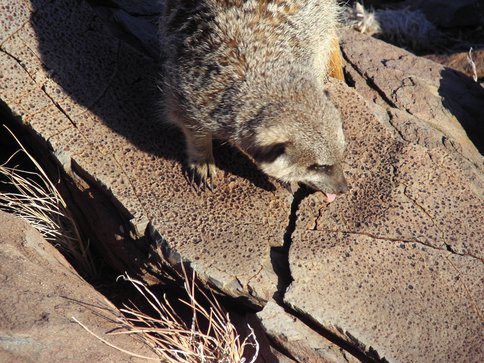2012 Annual Science Report
 VPL at University of Washington
Reporting | SEP 2011 – AUG 2012
VPL at University of Washington
Reporting | SEP 2011 – AUG 2012
Understanding Past Earth Environments
Project Summary
For much of the history Earth, life on the planet existed in an environment very different than that of modern-day Earth. Thus, the ancient Earth represents a planet with a biosphere that is both dramatically different than the one in which we live, but that is also accessible to detailed study. As such, it serves as a model for what types of biospheres we may find on other planets. A particular focus of our work was on the “Early Earth” (formation through to about 500 million years ago), a timeframe poorly represented in the geological and fossil records but comprises the majority of Earth’s history. We have studied the composition and pressure of the ancient atmosphere; modeled the effects of clouds on such a planet; studied the sulfur, oxygen and nitrogen cycles; and explored atmospheric formation of molecules that were likely important to the origins of life on Earth.
Project Progress
Over the past year, we have advanced our understanding of Earth environments through studies of the Archean hydrosphere, atmosphere, and lithosphere, as well as work that examines the energy distribution of the Sun at the time. We have utilized isotope records – those of sulfur in particular – to learn about redox cycling in the Archean ocean, the metabolisms active at the time (Buick et al., 2011), and the implications for the development of land on continents (Stüeken et al., in press). Interpretations of similar sulfur isotope records with photochemical models have provided insights on the Archean atmosphere – specifically that the atmosphere may have oscillated between a thick-haze and thin-haze state (Zerkle et al., 2012). Because hazes and sulfur cycling would have been significantly affected by biological activity, both of these studies provided insights into the biological metabolisms active at the time. Previously, the atmospheric models used in such studies had no geological constraints on atmospheric pressure, but our team provided the first of these in the form fossilized raindrop craters (Som et al., 2012.) In this work, we demonstrated a new “paleobarometer” that constrained Archean atmospheric pressures to be within a few times modern-day atmospheric pressure. This study showed that elevated atmospheric pressure from higher nitrogen levels was not responsible for warming the early Earth (and thus making it a habitable planet) illuminated by the “Faint Young Sun”. The energy distribution of the “Faint Young Sun” (with respect to wavelength across wavelength) Finally, was examined in a separate study that combined observations of nearby stars to produce a detailed model how the Sun’s spectrum would have evolved over the Earth’s history (Claire et al., 2012). Both the ocean and atmosphere play a role in our modeling of the redox budget of the early Earth and in determination of the “great rise of atmospheric oxygen” around 2.5 Ga (Kasting, 2012). We have also studied how these surface reservoirs have been affected by the lithosphere and the subsurface (Sleep et al., 2011). All of these studies inform our knowledge of the early history of life on Earth and improve our models of the interactions between these major planetary reservoirs.
A meerkat licking Archean raindrop impact craters, the size of which indicates that atmospheric density ~2.7 billion years ago was similar or lower than now.
Publications
-
Buick, R. (2012). Geobiology of the Archean Eon. Fundamentals of Geobiology, None, 351–370. doi:10.1002/9781118280874.ch19
-
Claire, M. W., Sheets, J., Cohen, M., Ribas, I., Meadows, V. S., & Catling, D. C. (2012). THE EVOLUTION OF SOLAR FLUX FROM 0.1 nm TO 160 μm: QUANTITATIVE ESTIMATES FOR PLANETARY STUDIES. The Astrophysical Journal, 757(1), 95. doi:10.1088/0004-637x/757/1/95
-
Kasting, J. F. (2014). Modeling the Archean Atmosphere and Climate. Treatise on Geochemistry, None, 157–175. doi:10.1016/b978-0-08-095975-7.01306-1
-
Kasting, J. F., & Canfield, D. E. (2012). The Global Oxygen Cycle. Fundamentals of Geobiology, None, 93–104. doi:10.1002/9781118280874.ch7
-
Ogden, D. E., & Sleep, N. H. (2011). Explosive eruption of coal and basalt and the end-Permian mass extinction. Proceedings of the National Academy of Sciences, 109(1), 59–62. doi:10.1073/pnas.1118675109
-
Sleep, N. H. (2012). Maintenance of permeable habitable subsurface environments by earthquakes and tidal stresses. International Journal of Astrobiology, 11(04), 257–268. doi:10.1017/s1473550412000122
-
Sleep, N. H., Bird, D. K., & Pope, E. C. (2011). Serpentinite and the dawn of life. Philosophical Transactions of the Royal Society B: Biological Sciences, 366(1580), 2857–2869. doi:10.1098/rstb.2011.0129
-
Som, S. M., Catling, D. C., Harnmeijer, J. P., Polivka, P. M., & Buick, R. (2012). Air density 2.7 billion years ago limited to less than twice modern levels by fossil raindrop imprints. Nature, 484(7394), 359–362. doi:10.1038/nature10890
-
Summons, R. E., Amend, J. P., Bish, D., Buick, R., Cody, G. D., Des Marais, D. J., … Sumner, D. Y. (2011). Preservation of Martian Organic and Environmental Records: Final Report of the Mars Biosignature Working Group. Astrobiology, 11(2), 157–181. doi:10.1089/ast.2010.0506
-
Zerkle, A. L., Claire, M. W., Domagal-Goldman, S. D., Farquhar, J., & Poulton, S. W. (2012). A bistable organic-rich atmosphere on the Neoarchaean Earth. Nature Geosci, 5(5), 359–363. doi:10.1038/ngeo1425
-
PROJECT INVESTIGATORS:
-
PROJECT MEMBERS:
David Des Marais
Co-Investigator
Watson Gregg
Co-Investigator
Tori Hoehler
Co-Investigator
Victoria Meadows
Co-Investigator
Shawn Domagal-Goldman
Postdoc
Colin Goldblatt
Postdoc
Jacob Haqq-Misra
Graduate Student
John Baross
Unspecified Role
April Roberson
Unspecified Role
Yuk Yung
Unspecified Role
-
RELATED OBJECTIVES:
Objective 1.1
Formation and evolution of habitable planets.
Objective 1.2
Indirect and direct astronomical observations of extrasolar habitable planets.
Objective 4.1
Earth's early biosphere.
Objective 4.2
Production of complex life.
Objective 5.1
Environment-dependent, molecular evolution in microorganisms
Objective 5.2
Co-evolution of microbial communities
Objective 6.1
Effects of environmental changes on microbial ecosystems






